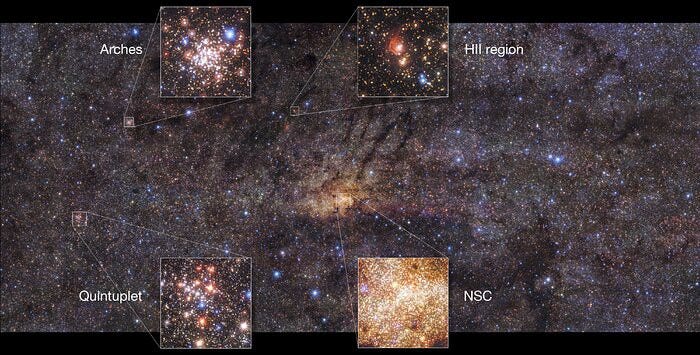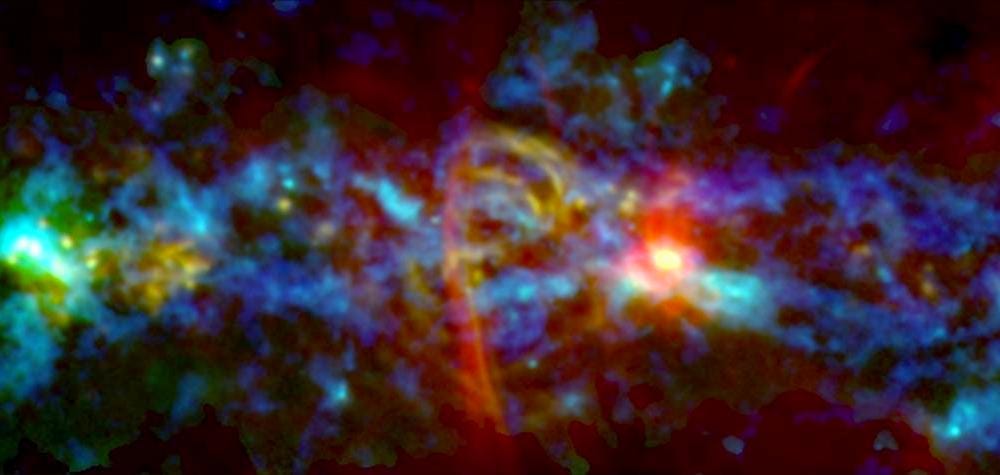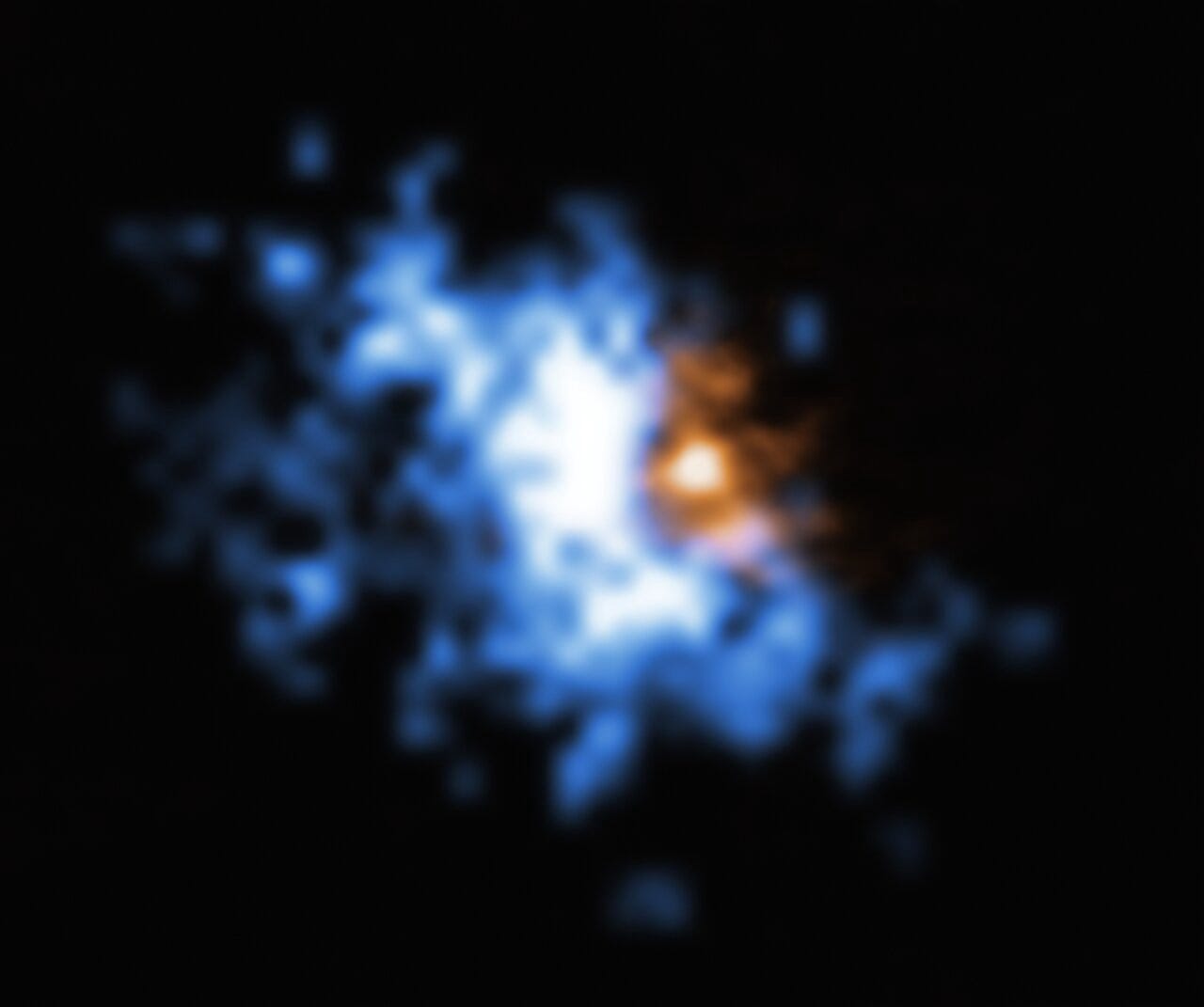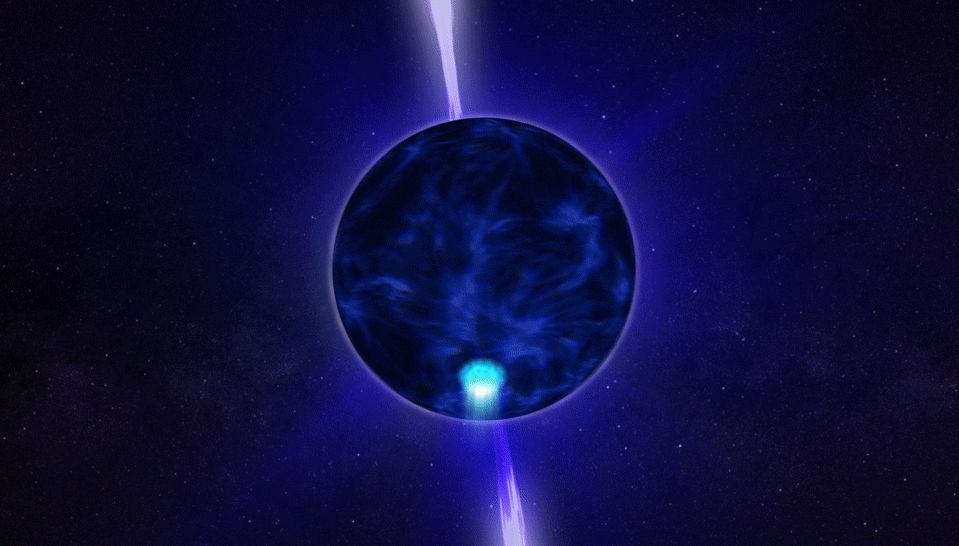The Cosmic Companion December 21, 2019
Happy holidays! Black holes, exploding stars, and candy in space!
Hello everyone!
For our last newsletter of the year, we have some tasty treats! A period of frantic star formation may have resulted in thousands of supernova explosions, new evidence suggests that the supermassive black hole near the center of the Milky Way may have a companion, and astronomers spot a massive candy cane in our galaxy. Meanwhile, black holes from the early age of the Universe are seen gobbling down on gas, halos around pulsars could explain a mystery of cosmic rays, and new computer simulations may help us better understand exoplanets as light as cotton candy.
Listen and subscribe to Astronomy News with The Cosmic Companion through any major podcast provider, including iTunes, Spotify, or TuneIn! Or, listen in at: https://thecosmiccompanion.substack.com.
The Cosmic Companion also offers a premium newsletter, featuring weekly exclusive videos, the astronomy comic of the week, and more. Just $5 a month, or $50 a year! Sign up at: https://thecosmiccompanion.substack.com.
Or, you can buy me a cup of coffee for my work!
Let’s take off!
The Week in Space
Ancient Star Burst Found in the Centre of our Galaxy
By Rob Lea
A violent burst of star formation led to hundreds of thousands of supernova explosions at the centre of the Milky Way new observations reveal.

This beautiful image of the Milky Way’s central region, taken with the HAWK-I instrument on ESO’s Very Large Telescope, shows interesting features of this part of our galaxy. This image highlights the Nuclear Star Cluster (NSC) right in the centre and the Arches Cluster, the densest cluster of stars in the Milky Way. Other features include the Quintuplet cluster, which contains five prominent stars, and a region of ionised hydrogen gas (HII).(ESO/Nogueras-Lara et al)
Researchers have used the HAWK-1 instrument, part of the ESO’s Very Large Telescope (VLT) array, based in the Atacama Desert, Chile, to study the Milky Way’s central region in unprecedented detail. The study has resulted in the discovery of the remnants of an ancient burst of intense star formation. This period represented by this ‘cosmic fossil’ led to another dramatic event in our galaxy’s history — a burst of supernova explosions. Hundreds of thousands of them.
Read more: http://bit.ly/Ancient-Star-Burst-Galaxy
A Second Supermassive Black Hole May Hide at the Center of the Milky Way
By James Maynard
Could a second supermassive black hole be orbiting the one we already know about near the mysterious core of the Milky Way galaxy? New studies suggest our black hole may have a dark, mysterious companion.

A primitive supermassive black hole at the center of a young star-rich galaxy. Image credit: NASA/JPL-Caltech
Nearly every galaxy astronomers have ever seen contains a supermassive black hole near its center, and our own Milky Way is no exception. However, new research suggests that this invisible behemoth may also have a dark, mysterious partner, orbiting it from afar.
Near the center of the Milky Way sits Sagittarius A* (pronounced “Sag A star”), our local supermassive black hole. Despite its mass, four million times greater than the Sun, this is a sleeping giant. The object is relatively quiet (as far as galactic black holes go), although some signs of increased activity have recently been seen.
Read more: http://bit.ly/Second-Supermassive-Black-Hole
Candy Cane Spotted in Space for a Cosmic Holiday Treat
By James Maynard
Near the center of the Milky Way, astronomers found a giant candy cane, just in time for the holidays. This structure is truly one sweet treat!

A “candy cane” in space, seen in a composite image released just in time for the holidays. The bright spot to the right is the supermassive black hole near the center of our galaxy. Image credit: NASA’s Goddard Space Flight Center.
The center of the Milky Way is home to the densest collection of molecular gas clouds in the galaxy, providing enough material to form tens of millions of stars. It is also home to a massive candy cane, seen in a new composite image created by a pair of researchers from Johns Hopkins and the University of Maryland.
The Goddard-IRAM Superconducting 2-Millimeter Observer (GISMO) was used to capture light from the inner part of our galaxy, which were pieced together with other images into a composite photo, revealing this giant galactic candy cane. This instrument is attached to the IRAM 30-meter radio telescope in Veleta, Spain.
Read more: http://bit.ly/Candy-Cane-Space-Holidays
Black Hole’s Breakfast at the Dawn of Time
By Rob Lea
Using the ESO’s Very Large Telescope astronomers have stared back in time and observed reservoirs of cool gas around early galaxies, a perfect larder allowing the growth of supermassive black holes.

This image shows one of the gas halos newly observed with the MUSE instrument on ESO’s Very Large Telescope superimposed to an older image of a galaxy merger obtained with ALMA. The large-scale halo of hydrogen gas is shown in blue, while the ALMA data is shown in orange. The halo is bound to the galaxy, which contains a quasar at its centre. The faint, glowing hydrogen gas in the halo provides the perfect food source for the supermassive black hole at the centre of the quasar. Image credit: ESO/Farina et al.; ALMA (ESO/NAOJ/NRAO), Decarli et al.
Astronomers have spotted gas halos around the earliest galaxies — a food supply for supermassive black holes. These halos — seen as they were over 12.5 billion years ago — could explain how these cosmic monsters grew so rapidly during a period in the Universe’s history known as the Cosmic Dawn.
“We are now able to demonstrate, for the first time, that primordial galaxies do have enough food in their environments to sustain both the growth of supermassive black holes and vigorous star formation,” says Emanuele Paolo Farina, of the Max Planck Institute for Astronomy in Heidelberg, Germany, who led the research published in the Astrophysical Journal. “This adds a fundamental piece to the puzzle that astronomers are building to picture how cosmic structures formed more than 12 billion years ago.”
Read more: http://bit.ly/Black-Hole-Breakfast
Halo Around Pulsar Could Answer Mystery of Antimatter
By James Maynard
Larger than the Big Dipper as seen from Earth, a faint halo surrounding an energetic dead star could answer one of the great mysteries of cosmic rays and help reveal the behavior of pulsars.

A pulsar is a neutron star which emits powerful beams of radiation, which can be seen from Earth, if the alignment is right. Image credit: Image credit: NASA’s Goddard Space Flight Center
The Fermi Space Telescope, launched in 2008, first recorded a faint haze of high-energy light around a nearby stellar corpse called a pulsar. Now, a new analysis of the data suggests this object may play a critical role in the production of the cosmic rays which bathe our Solar System.
Pulsars are the remains of massive dead stars, which emit powerful beams of radiation that, under ideal conditions, can be seen from Earth. One of these stellar corpses, Gemina (geh-MING-ga), was recently found to be encompassed by an enormous, although tenuous, region of high-energy radiation.
Read more: http://bit.ly/Halo-Pulsar-Antimatter
Planets as Light as Cotton Candy
By James Maynard
Of more than 4,000 known exoplanets, 15 have densities around that of cotton candy. What do we know about these odd super-puff worlds?

Kepler 51 d (closeup) with Kepler 51 C in the background, as it would appear near closest approach between the two worlds. Image credit: The Cosmic Companion | Created in Universe Sandbox
Astronomers once believed that most solar systems would be much like our own, with small rocky planets near their sun, accompanied by gas giants orbiting the star at greater distances. Beginning in 1992, researchers began to find worlds orbiting alien stars, and soon found solar systems came in a wide variety of formations.
Today, astronomers know of more than 4,000 worlds orbiting other stars. Of these, 15 have exceedingly low densities, lower than that of cotton candy.
Three of these planets — dubbed super-puff worlds — are found in the Kepler 51 star system, 2,600 light years from Earth. Larger than the size of Jupiter, these planets contain less than one percent of the mass of the largest planet in our solar system.
Read more: http://bit.ly/Planets-Light-Cotton-Candy

Coming soon: The First Woman on the Moon: The Past and Future History of Women in Space by James Maynard
Thanks for reading!
This is the last newsletter of the year for us, and I am looking forward to the holidays and my upcoming marriage and honeymoon! I’m very excited about upcoming changes for The Cosmic Companion, which will offer new and exciting features, articles, and more.
You can also listen to my new podcast, Astronomy News with The Cosmic Companion, available on all major podcast distributors, including iTunes, Spotify, and TuneIn! Or, tune in at: https://thecosmiccompanion.substack.com. You can also now add Astronomy News with The Cosmic Companion to your flash briefings on Amazon Alexa!
If you want to keep up with the latest updates and news about astronomy and space exploration, visit www.thecosmiccompanion.com, join my Facebook page, subscribe on YouTube, and follow @TheCosmicCompanion on Instagram and @CompanionCosmic on Twitter.
Remember - VIP subscribers receive this newsletter, plus a second weekly newsletter with sneak previews of each video episode of Astronomy News with The Cosmic Companion, an astronomy comic of the week, rare space photos, and more! Plans start at just $5!
Do you know someone else who would love this newsletter? Please share! Invest in knowledge with a premium subscription for yourself or a loved one today (including advance viewings of my weekly video show)! Or, I’d love it if you could buy me a cup of coffee - I LOVE coffee!
Thanks, and happy holidays — see you on January 11th!
Astronomy - Don’t Leave Home Without It!
- James


